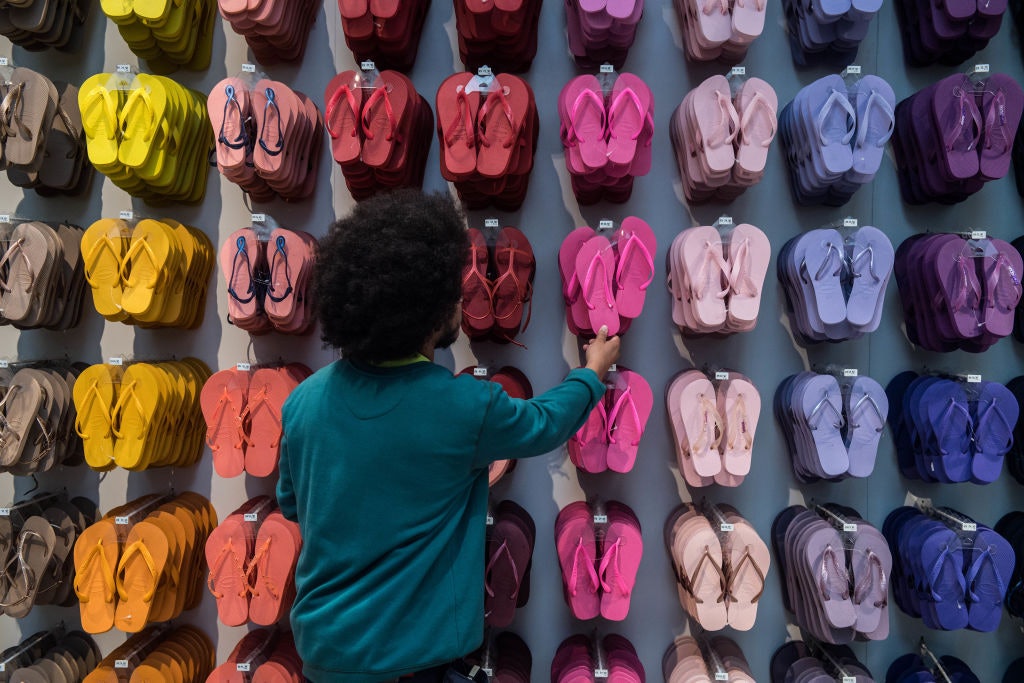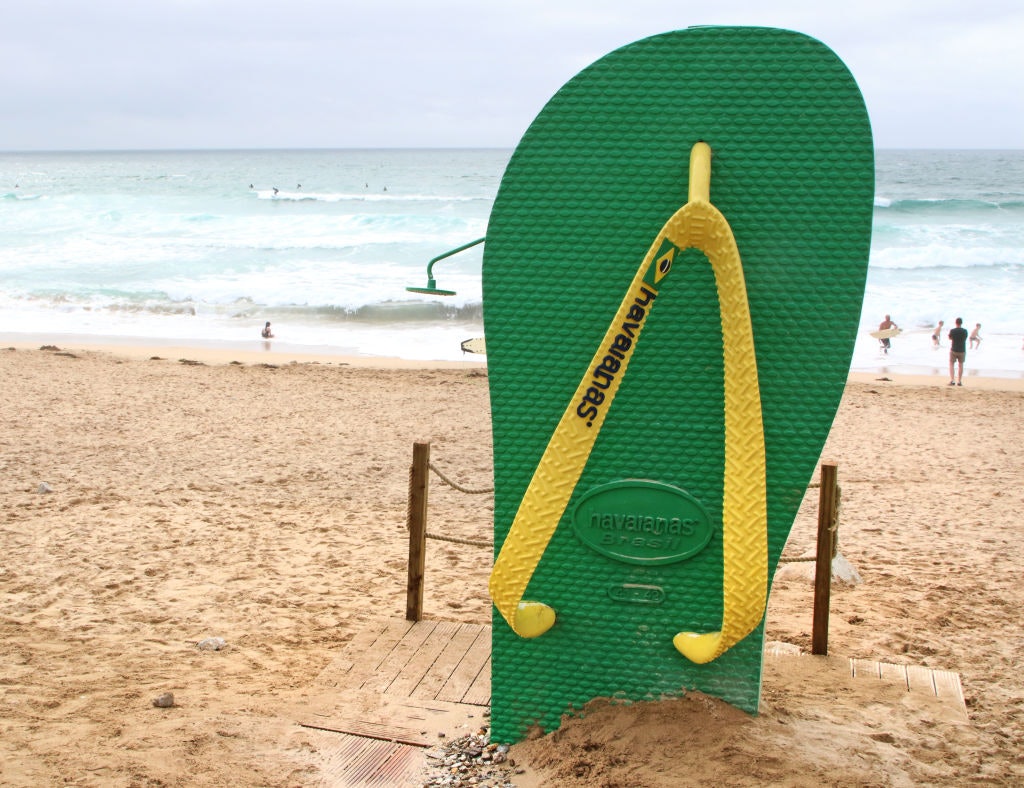
The 30 best countries, cities and regions to visit in 2025

May 2, 2023 • 6 min read

Havaianas are the ultimate Brazilian footwear © Paulo Fridman / Getty Images
I never thought of a shoe as versatile. Sure, you can wear them, but how many more uses can they have other than as footwear? Then I saw Brazilians and their Havaianas...
Havaianas are as Brazilian as rice and beans. Pele and Ronaldo. Literally, everyone owns a pair. They probably own two, or five, even 10 pairs. In 2022, a record of 260 million Havianas were sold worldwide – nearly 75% of which were sold in Brazil.
They're the most popular and versatile footwear in the country. You can wear them to the beach, the shops, dinner, or even a party. My friend handed out Havianas at her wedding so that the guests didn't have to wear their heels all night.
Havaianas are also a great substitute for slippers when the floor is cold. They make perfect goalposts for beach football. They are the solution for a wobbly bar table. They even make good doorstops. I've seen them used to kill mosquitos and to pull a hot pan out of the oven (OK, they melted a little).
They're one of the most versatile shoes in existence, and in Brazil, you'll see them absolutely everywhere. But how did Havianas become such an integral part of Brazilian culture?

Once upon a time, Scottish businessman Robert Fraser fell in love with a shoe: a Japanese sandal called a Zori. It had soles made from rice straw and fabric strips that ran across the foot and between the toes.
Fraser wanted a sturdier version. Something that could withstand the beach lifestyle in Brazil. So in 1962, he took some high-quality rubber – accessible and cheap in the country – and molded his own Zori-like sandals. He even included a rice grain texture on the sole in a nod to their Japanese inspiration.
Those sandals were the first pair of Havaianas. Named after Hawaii (Havaí, in Portuguese), they were designed to be the perfect footwear for a laid-back island lifestyle. Little did Fraser know, Havianas would soon become synonymous with beach life across the globe.
Made of blue and white rubber, the first pair were called the Tradi. Traveling salesmen took them across the country in Volkswagen Kombi campers. They would park in front of local shops in small towns to promote their new product from São Paulo, the big city.
Havianas were an instant success. It wasn't long until nearly every Brazilian was wearing a pair. Only available in white and blue at first, a production error at the factory in 1969 caused the straps to come out green. They went to market – and people loved them. They became so popular that yellow, black and dark red versions all appeared soon after.
By the 1980s, millions of Havianas were being sold across the country. They were so ubiquitous that during the inflation crisis, the Brazilian government declared Havaianas an essential item, adding them to the list of fixed-price goods – alongside staples like rice and beans.

Tired of the white-colored soles, Brazilians began to turn the soles of their Havaianas upside down to show the colorful bottoms, creating single-colored flip-flops. Brand execs noticed the trend and began to produce single-color styles dubbed Tops. A sole featuring a hibiscus flower became the first-ever printed version.
From there, line expansions never slowed. New colors and prints constantly developed, and new styles – such as baby Havis (Havaianas for toddlers) – were born.
In 1998, to celebrate the World Cup, Havaianas launched their Brazil shoe: a yellow and green flip-flop with a Brazilian flag on the strap. Although Brazil never won the tournament, the new Havianas were a sweeping success. The Brazil version remains one of the brand's best-selling designs.
One year later in 1999, Havianas made their runway debut at the show of French fashion designer Jean Paul Gaultier, marking the beginning of the brand's global recognition. By the early 2000s, celebrities such as Naomi Campbell, Jennifer Aniston and Madonna were all sporting pairs of the fun, colorful and affordable footwear.
Thanks to partnerships with brands like Disney and the Oscars ceremony, Havianas hit the international spotlight, even appearing in a 2018 MoMA exhibition in New York as a piece of art.
Some Havaianas have impressive price tags, like H.Stern's 2003 collaborative pair, decorated with 1,636 gold feathers and adorned with diamonds which clocked in at R$ 58,500 (USD$11,585); though the most expensive pair of Havaianas that you can't wear award goes to the flip-flops entitled Happy Feet, a collaboration with the artist Adhemas Batista and the brand. Part of a collection called Felicidade, Happy Feet were sold as an NFT in the metaverse for a price equivalent to R$ 5,600 (USD$11,009) in 2023.
Depending on where you buy them and the style you purchase, Havianas in Brazil generally cost between R$15 (US$3) to R$50 (US$10). In the US, prices range from US$15 to US$38.
During the brand's rise to fame, many have tried to imitate Havianas' style and simplicity, without much success. The only flip-flop that's come close is the Ipanema Sandal, launched in 2002 by Brazil's largest shoemaker, Grendene, and endorsed by supermodel Gisele Bündchen.
Ipanema Sandals are made of PVC, so they feel softer underfoot, although many believe Havaianas rubber formula leads to longer wear. Still, with Bündchen's backing Ipanema Sandals gained a meaty portion of the international market share.
Most Brazilians still believe that there's nothing like the original though. Although Havaianas now sell in more than 100 countries across the world, inside Brazil they still reign king, and this simple rubber flip-flop is synonymous with Brazilian culture and the laid-back lifestyle that Fraser had hoped to represent.

Many families have indoor Havis, used like slippers for keeping their feet from cold floors, and outdoor Havis for wearing on the street.
If someone needs to pop outside, it's totally natural for them to grab whatever pair of Havaianas are handy, no matter whose they are – especially if it saves putting on real shoes.
When you hit the beach, you can fold your Havaianas in half towards the straps, then slide them up your arms. If you're without a bag, it’s the best – and most Brazilian – way to carry your shoes across the sand. It’s a great trick for beach joggers too.
How you wear your Havaianas in Brazil varies by region. In the colder, southern regions, you'll see Havi's mostly in the summer and on the beach, while in the Northeast, where it's always hot and Havi's are produced, they're practically the only footwear acceptable.
In São Paulo, Havaianas are overly casual, while in Rio de Janeiro, you can easily wear them to a restaurant or on a night out.
In Brazil, leaving your Havis upside down is considered bad luck – if you do, they say Mata-Mãe (mom will die)!
You can buy Havaianas anywhere in Brazil – from pharmacies to street kiosks, but there are also official shops across the country offering an almost absurd range of colors, styles, and sizes. You can even customize your own pair.
Havaianas are significantly cheaper to buy in Brazil than anywhere else in the world, so you might need an extra suitcase to bring back enough pairs for your family and friends.